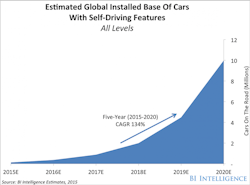5G’s Important Role in Autonomous Car Technology
The momentum for the realization of autonomous vehicles in mainstream use is reaching critical mass. Companies such as Tesla and Toyota are now testing self-driving vehicles on the roads in places like Pittsburgh, Boston, and Phoenix. But while many Americans already had grave concerns surrounding driverless cars, a recent fatal accident by an autonomous Uber vehicle has many questioning if autonomous cars will ever be safe enough to feel confident with them sharing our roads.
Still, with self-driving features already in widespread use, it does appear that fully autonomous cars will be appearing on our roads, and perhaps sooner than people realize. Even more surprising, they will also be considered much safer than human-controlled vehicles.
Self-driving car features are already becoming popular with car makers. (Credit: Business Insider)
For autonomous car technology to be unlocked, many experts agree that large-scale adoption of 5G—the next-generation wireless technology—is required. The current 4G network is fast enough to online stream full HD content and play online games, but it can’t support safer and smarter autonomous cars.
Said Nokia’s Jane Rygaard in a recent interview with the BBC: “We need to look at how long it takes for the message to be transmitted between sensors and then get to the computer in each car, and then how long it takes for the computer to make a decision, and all of this has to be in less time than a human would take to make a decision—2 milliseconds. We need a network supporting this, and 5G is that network.”
The current 4G network is simply not fast enough to provide the capability to give autonomous vehicles human-like reflexes that may have prevented the Uber vehicle fatality.
Driverless cars are just one of the many incredible technologies that are likely to be ushered in with 5G. Virtual reality and artificial intelligence are two more examples of the breakthroughs that we can expect once the data network catches up with technological advancement.
Evolution of the Networks
The wireless data network has advanced steadily over the past 30 years, and some life-changing technologies have been hot on its heels. The modern evolution began in the early ’80s with the introduction of the first-generation analog cellular system. Though cell phones were still relatively rare, people could finally talk to each other on the go.
By the early ’90s, second-generation and 2.5G mobile systems enabled people to send text, but it wasn’t until the start of the new millennium that people had access to broadband-speed internet through 3G. Phones evolved from devices for making calls to a tool for multifaceted communication, entertainment, shopping, and much more.
4G is the latest evolution, and it offers enough bandwidth and speed to allow real-time information- and location-sharing. This evolvement enabled the sharing economy and helped give birth to companies like Uber and Lyft. However, it’s still not fast enough to support technologies that require the speed of human reflexes. That’s where 5G comes in.
Why 5G is Crucial for Autonomous Cars
The fifth-generation wireless technology is expected to connect almost everything around us with an ultra-fast, highly reliable, and fully responsive network. 5G will allow us to leverage the full potential of advanced technologies such as artificial intelligence, virtual reality, and the Internet of Things (IoT).
Self-driving cars use hundreds of sensors to make vehicles faster and smarter. These sensors generate unprecedented amounts of data, much more than any other IoT adoption would. Handling, processing, and analyzing this amount of data requires a much faster network than the existing 4G technology. Autonomous cars, systems require incredible data processing capabilities and speeds needed to mimic the timing of human reflexes.
According to Dr. Joy Laskar, CTO of Maja Systems, future autonomous cars will generate nearly 2 petabits of data, which is equivalent of 2 million gigabits. “With an advanced Wi-Fi connection, it will take 230 days to transfer a week-worth of data from a self-driving car, and that is why we need much faster ASIC processing technology and products,” Laskar said.
The world’s leading semiconductor companies, such as Intel and Qualcomm, are advancing toward an ASICs revolution, combining large available bandwidth at 5G frequencies with new innovative digital radio and antenna architectures. Simply put, these companies are creating chips to turn autonomous vehicles into mobile data centers, allowing driverless cars to make real-time, complex decisions.
Market watchers say that 5G, when adopted at the full scale, will offer internet speeds up to 100 times faster than 4G. It will present exciting possibilities for the automobile industry used for vehicle-to-vehicle (V2V) and vehicle-to-everything (V2X) connectivity. Furthermore, the technology’s low latency will make these vehicles extraordinarily safe and reliable on the roads—safer than vehicles today that are operated by people.
Communication technology like V2V and V2X will provide car connection to 5G networks. (Credit: Qualcomm)
Edge Computing Powered by 5G
Offering a range of advantages, edge computing is recognized by many experts as one of the latest significant enterprise trends. Edge computing refers to infrastructure that allows data processing as close to the source as possible, enabling faster processing of data, reduced latency, and overall better outcomes. When it comes to edge computing, there are many challenges in terms of network reliability.
With autonomous cars comes the responsibility of managing the infrastructure which processes massive amounts of unstructured data and privacy protection when collecting sensitive data at the edge. Edge computing will allow lightning-fast response time because of 5G’s promise of lower latency and ability to offload computing tasks and better location awareness.
Remote Pilots
Another key reason why 5G is crucial for autonomous cars is the inclusion of specific safety measures in the vehicle. For example, suppose a self-driving car fails to navigate due to a traffic jam caused by a road accident.
The autopilot feature might hand the reins over to the driver. However, it would not be possible in case of an elderly or a disabled rider. For this reason, many tech companies have been testing remote pilots, who are trained drivers sitting miles away in a simulator that can take over instantly. However, to achieve it, a stable and fast connection offered by 5G would be crucial.
Additionally, 5G will provide passengers in self-driving cars with high-quality infotainment services. It will make communications service provider an important partner for autonomous cars, whether for data analytics, safety, or entertainment reasons.
Further opportunities for 5G technology to enhance self-driving car technology exist. These opportunities are yet to be explored by regular examination of the safety performance of autonomous vehicles.
If you are concerned about driverless cars on the road, think about the evolution of smartphone devices over the past few decades. At one point, you probably couldn’t even imagine being able to make a call to someone on the other side of the world from a pocket-sized device. Today, you can’t imagine a day without the ability to connect to friends, family, and colleagues around the world using your mobile phone.
Technology and network evolution bring incredible and useful advancements to society. 5G’s promises to bring safer and smarter self-driving cars would be one of the most remarkable developments of our time.



